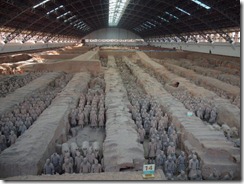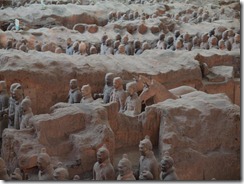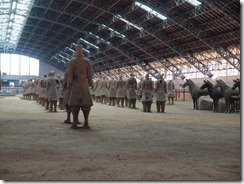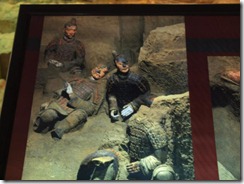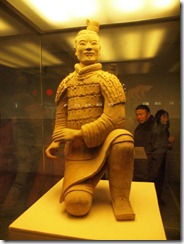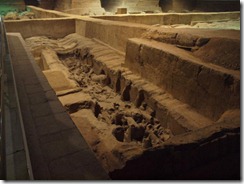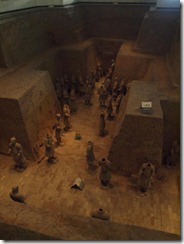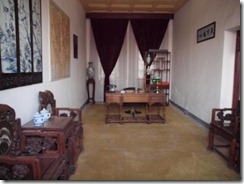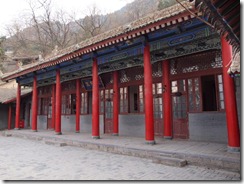Today we bid adieu to our brief, baffling and unsettling stopover in Beijing and continued our way back towards home. Our final destination before returning to HangZhou is the old city of Xi’an, one of the older inland former capitals of China. It is home to the world famous Terracotta Warriors, and much, much more.
Realistically, you need at least two or three days to see what Xi’an has to offer. As it turns out, we didn’t plan this leg of our trip particularly well; we should’ve flown from Harbin directly to Xi’an, instead of stopping extremely briefly in Beijing. At any rate, and at some cost, we managed to pack in a visit to four attractions around Xi’an’s greater area.
As you may have read in a previous post, our adventures last night in Beijing were not positive. We left early this morning still in quite a bad mood, and by the time we arrived in Xi’an our mood had somewhat lightened. Faced with the prospect of battling our way downtown, and finding a taxi to take us out to the famed Warriors was a daunting prospect in light of the previous evening’s events.
When we went to buy a map of the Xi’an area, we were offered a car and driver plus entrance fees to three attractions for 850 RMB, which sounded somewhat fair to weary travellers. The admissions cost to our first stop was 20 RMB/person, the Warriors 90 RMB/person, and another 40 RMB/person to the third attraction. We estimate the total admissions cost would have been at least 300 RMB, so for roughly 550 RMB (less than $100 AUD) we had a driver and car for eight hours.
So, our itinerary had us missing downtown Xi’an altogether – a bit of a shame, but given the geography and the time constraints, it was unlikely we would have had much time there anyway. We were taken to a booth where Toni paid using her Bank of China card, then we were walked up to the departure roadway and were put into a car. There was a bit of a delay while our driver waited for the money for entrance fees, then we were off.
After a brief stop for fuel nearby, we hit the freeway to the north east of Xi’an towards the area where the Terracotta Warrior museum is located. Our first stop we misheard as a ‘bamboo museum’, but it turned out to be the Banpo Site Museum. I remember watching Toni searching through the Museum Tour guide we’d been given trying to locate the non-existent Bamboo Museum ![]()
The Banpo Site Museum turned out to be quite interesting; the original excavated site of a Neolithic village from about 4000 BC. They have managed to extract quite a collection of Neolithic-era pottery as well as funeral urns, and human remains buried according to ancient ritualistic ceremony. The physical evidence supports a number of theories about the structure and layout of the village as well as providing an insight into how the village was constructed.
Neolithic Era Village Site
The main building covers the majority of the museum and contains three distinct areas; residential, pottery making and burial and occupies about 50,000 sqm. We did a brief walkthrough of the main attractions, though you will see from some of the photos, there were only scattered features in the main areas. There were additional display areas off the main site which showed the remains of various Neolithic inhabitants of the village, the bones still oriented the way they were buried over 6,000 years ago.
Once we had finished, we returned to our driver, and continued on to the next location. The Terracotta Warriors and Horse Museum is one of the main attractions in Shaanxi province, and is a UNESCO World Heritage listed site. As we arrived we were greeted by an English speaking tour guide who offered his services for an outrageous 150 RMB. I wasn’t really sure how much he could really add to the visit because I was already fairly well versed on the site and its history.
Eventually, for reasons surpassing my understanding, we agreed to hire him at 100 RMB. He led us into the site and took us to the vehicle transit (an additional 5 RMB per person) to make our journey to the main site faster. Lord knows why the entrance is located so far from the main dig sites! The transit should have been free. The entrance is built to accommodate the various retail outlets and restaurants which are on site and form the way out when you are finished later.
Anyway, we arrived at the main site (separate from the mausoleum, which is 1.5 kms away) which contains four main buildings of interest (and one building full of retail evils). We started with the main museum, which was simply a two storey building containing many artefacts from the dig site. It was somewhat interesting, but our guide was a bit boring and obvious. He didn’t really add much to the knowledge I already had, although he was able assist Toni while I took some photos.
A kingdom of underground warriors – facing East
After briskly charging through the museum, having some quite obvious points made to us (yes, it was starting to annoy me already) we finally made it into the main dig site. Here we were able to take our first view of the famous Warriors, lined up in their original locations. At this juncture our guide did something useful – he snapped some photos of Toni and I together, before filling in some blanks in terms of details about the dig site.
The dig site is presently located underneath a large full enclosed roof. There is a viewing platform located right around the circumference of the site with an elevated platform at the entrance. It is really built to handle very large numbers of tourists; we were visiting in the low season, so there were not great numbers of visitors.
More warriors at the rear of the first site
Some brief history – the site was originally discovered in 1974 by a couple of farmers who were sinking a well. The Warriors and associated terracotta belong to the Qin dynasty and date from around 220 BC. The entire site is much, much larger than what has been excavated to date; it extends for kilometers and most of the site has not been unearthed yet. The site represents a copy of the Imperial capital at the time of the Qin Emperor, complete with his army, horses and armour.
The reason that the site has only been partially excavated is that during the initial digging, they found that within hours of exposing the terracotta to air, the lacquer on the Warriors dissolved and the brilliant statues lost all their original colouring, which had been perfectly preserved in their air tight compounds. China has been patiently (and wisely) waiting until technology is developed to prevent this destruction of the lacquer before excavation of the main mausoleums.
A picture of a picture of the statues with colour
It takes approximately six months for a single Warrior to be fully excavated and rebuilt. All but one Warrior are found in pieces, the result of time and compacting of the Earth. The one lone Warrior found completely intact has been dubbed the “Lucky Warrior” and resides today inside the second site.
Some of the Warriors were taken on a journey overseas where they were exhibited in many famous museums – Australia was one such country to receive the Warriors for a brief period, however this was in 1983 when I was only four years old!
We walked around the perimeter of the first dig site viewing the un-excavated sites as well as seeing first hand the remains of many broken soldiers, who will remain unworked as an example of how they were first found. At the end of the first complex stood a small battalion of soldiers representative of a cross section of different unit types, some found in other locations. Included were crouching archers, officers and infantry.
After taking a few photos, and posing for some extra shots, we moved onto the second site which only opened in 1995. This site is a lot less well lit, to preserve the contents of the site. It is not as large as the first site, but contained a more uniform layout and some better preserved remnants of the city’s construction and design. It is quite deep into the ground, at least 10 to 15 meters and the original entrances are still intact – 9 in total.
The “Lucky Warrior”
Here we visited the “Lucky Warrior” as well as one of the nine Generals which have been found thus far, and an officer. We then made for the exit, and moved across to the third site, which houses the command bunker. Slightly deeper than the previous sites, the bunker contained the bulk of officers and generals found to date. There were also remnants of representative sacrifices, and a special sacrifice chamber for this purpose. The third site is the smallest of the three main dig sites, but also contains interesting symmetry.
A Photo of the Second Site
Finally, we found ourselves inside the shopping complex (we were not told what the building contained) where, no doubt, our affable tour guide would’ve made a nice little percentage on anything we bought. One of the original farmers who found the site all those years ago was present and signing copies of books, but the pricing was outrageous – 200 RMB for a signed book and some post cards. Everything was over priced and I personally dislike the Chinese habit of tricking tourists into these traps; so we declined to buy anything. Honestly, we really don’t have much room for new things anyway and I can get books on the site easily enough elsewhere (and cheaper).
The Command Bunker
Our guide was quite dour after this, and basically just guided us to the exit, where we paid him the promised 100 RMB. On the way out he collected stamps from shops, which I presume was some sort of system for extracting money for sending tourists in the direction of said shops. I honestly dislike this strategy, if we had been able to roam freely (and not led), I might have bought something.
Once outside, starving, our driver drove us to a local Shaanxi style restaurant where we dined on some beef, eggplant and YangZhou styled fried rice. The cuisine was so-so, nothing to rave about, and moderately priced. The rice was the highlight, which tells you something. The restaurant was fine though, clean and tidy and the staff were friendly enough.
Lunch!
After lunch we were driven to our third destination, a hot springs resort called ‘Huaqing’ which is also the venue for a key moment in Chinese modern history – the Xi’an incident. For those of you who did not study modern Chinese history (unlike me) then you may not know much about the Chinese civil war. It lasted for over ten years and took place before the outbreak of World War II.
At the time China was a republic led by Chiang Kai-Shek and his party the Kuomintang (KMT). During the civil war, Chiang’s forces pursued the Communist party led by Mao Zedong, the father of present day China. The Xi’an incident involved Chiang when he set up a military command post in Xi’an (at the hot springs) whilst pursuing the Communists. Two of Chiang’s generals made a plea for the KMT to join with the Communist party to rebuke a Japanese incursion from the north.
He chose not to listen to them, so they took matters into their own hands and arrested Chiang. This led to a standoff between the Communist Party and the KMT and eventually led to a peace accord and joint co-operation against Japanese incursions in Manchuria.
We arrived at the location, and were taken with the age and style of the resort. Again we were harassed by an English speaking guide, but this time we strenuously turned her down. The location really spoke for itself – and there were plenty of signs in English explaining key locations and events anyway. The previous guide really sapped our tolerance for ‘helpful’ guides.
Entering, we took a less obvious route (instead of heading straight for the springs) and instead found ourselves at the location of the famous Xi’an incident – Chiang Kai-Shek’s command center. Sometimes I wonder if Chiang isn’t more popular on the mainland, the way his former residences are converted into museums! You hardly find similar locations for Mao or Chou En Lai, yet I’m sure they had refuges, command locations etc etc. Weird.
Chiang’s Office / The Five Room House (scene of the Xi’an Incident)
Anyhow, we eventually did walk around to the location of the springs – located underneath the only Imperial bathing houses left in China. These structures dated to the Tang dynasty and were frequented by Emperor Tang Ming and his lover Lady Yang. Although the bath houses are not in use anymore, they are still quite impressive, especially the main building which is huge.
Imperial Wash House
We managed to find a section where people were washing their feet in the mildly warm water, as well as several other locations where the springs were either previously in use, or currently used.
NOTE: Photos and more coming soon – check back!
